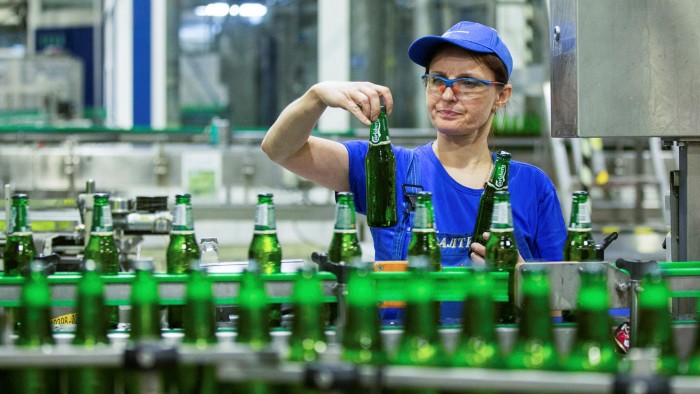Companies grapple with Scope 3 emissions climate challenge

Roula Khalaf, Editor of the FT, selects her favourite stories in this weekly newsletter.
Measuring emissions is sometimes like measuring calories in a diet — there is a touch of art along with the science. And, for companies, it is most difficult to be purely scientific over indirect, or “Scope 3”, emissions — the greenhouse gases emitted all along their supply chains and in the use of their products.
Think of Carlsberg selling a beer: its direct emissions come from its buildings, electricity and business travel. But its Scope 3 emissions cover all the steps to get the beer into the hand of the customer — such as purchasing barley, buying cans and transporting the bottled beverage. Carlsberg calls these its “beer-in-hand” emissions, and they represent more than 10 times its direct emissions from breweries.
That multiple is not unusual — Scope 3 emissions are typically the biggest part of a company’s carbon footprint and the hardest to measure. Yet, despite the challenges, more companies are trying to do so.
“You can’t really develop a decent climate change strategy unless you’ve looked at Scope 3,” says Tom Cumberlege, associate director at the Carbon Trust, a London-based non-profit climate consultancy. “Scope 3 is so crucial to all forms of climate change activity.”
In the past, companies tended to focus more on direct emissions, such as from their offices, cars and business travel — but that is no longer enough. “Business travel is usually fairly insignificant compared to value chain emissions,” Cumberlege says.
As more companies start to target net zero emissions, the importance of Scope 3 has grown, because a net zero target must include these indirect emissions. “You can’t avoid Scope 3 today,” says Rachel Delacour, co-founder at Sweep, a carbon management software start-up. “The large companies using our product, it is because they have pressure over their Scope 3.”
Data overload
The definition of Scope 3 emissions is laid out by the Greenhouse Gas Protocol, a joint initiative of World Resources Institute and WBCSD with the aim of keeping the global temperature rise below 1.5 degrees Celsius. It specifies 15 categories, including purchased goods, waste generated, fuel-related activities, use of sold products, investments, franchises and employee commuting.
For large companies, it is therefore a significant organisational challenge to track down all these figures.
“There is a lot of data to collect, which can be daunting,” says Cumberlege. “There is some uncertainty around how you could measure it . . . and most of these are, by definition, outside the influence of the business that is doing the reporting.” Companies “don’t necessarily know how to reduce in those sectors”.
Asking suppliers to cut the emissions of the products they supply is often one step in the process. For Carlsberg — which aims to reduce its “beer-in-hand” emissions by 15 per cent by 2022, compared with 2015 levels — that meant working with its packaging suppliers.
Packaging — including cans and bottles — accounts for 41 per cent of Carlsberg’s “beer-in-hand” emissions. But, after two of its can suppliers, Ball and Crown, started buying more renewable energy, that figure has begun to fall.
This knock-on effect — as companies with climate targets ask their suppliers to cut emissions — is one reason measuring Scope 3 emissions is a powerful exercise. The Scope 3 emissions of one company will be the Scope 1 and 2 emissions of another.
Financial risk
Investors are also turning to Scope 3 estimates as they try to understand the risks companies will face from rising carbon prices and more stringent national emissions policies.
Oliver Marchand, head of ESG research at securities index publisher MSCI, explains how his team recently developed a model that estimates Scope 3 emissions for about 9,000 companies.
“The biggest risk comes from the value chain — risk embedded in buying stuff that is carbon intensive,” he says. His new database of Scope 3 estimates allows investors to get a more holistic picture of a company’s exposure to changing climate policies.
“There are certain industries that are major contributors to climate change — like oil companies, car manufacturers, banks — and they have very low [emissions numbers] if you just look at Scope 1 and 2,” says Marchand. “It is a completely false analysis, and you don’t have to be a genius to see that in the data.
“Now, the risk models correctly calculate the difference between a traditional car manufacturer, like Volkswagen, and Tesla, because of the difference in their Scope 3 emissions,” he says. For carmakers, Scope 3 emissions include those from the vehicles that they produce.
More stories from this report
Can businesses deliver on their climate promises?
Consumers keen to be green but confused by companies’ claims
Banks feel the heat on financed emissions
How UK companies got a head start on cutting carbon emissions
We know net zero is the destination — now let’s get moving
Fashion fails to factor in supply chain carbon
There is still uncertainty in pinpointing precise figures for Scope 3 estimates. If different firms were auditing Scope 3 emissions for the same company, they would probably come up with slightly different numbers, Cumberlege says.
One question is how many steps down the value chain to go. Another challenge is making estimates for suppliers that do not already calculate their own emissions. Help may be on the way, though.
New technologies such as satellite imagery can help measure emissions at their source. And digital technologies and digitised supply chain management mean emissions data will become more robust.
Marchand envisions a world with “massive distribution of IoT [internet of things] devices that measure carbon dioxide for all sorts of facilities and machinery”, and thinks that may not be far away.
Scope 3 emissions may be tricky to measure now, he says, but it will get easier.
Comments